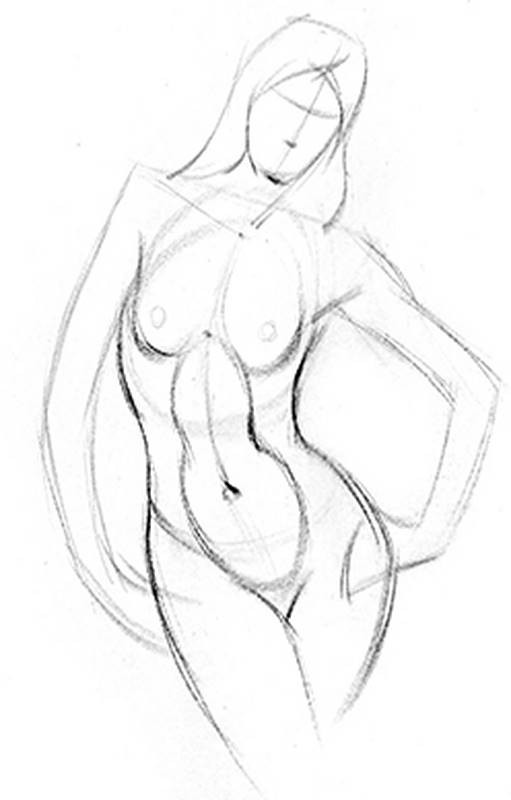Premium Version
Check out the extended premium video to learn about ab physique variations, 10-pack abs, belly buttons, transversus abdominis, the pyramidalis and more. All the anatomy premium lessons have 3d models and ebooks.
This is Part 2 of Drawing the Abs. Make sure to watch Part 1 where we learn about the anatomical structure of the abs. Now let's move on to Form.
Form
A classic idealization of the abs in profile resembles the letter B. It starts with an upward plane bulging outward over the ribs. Then it curves back in until it hits the 40 oz. Sometimes you'll see a flatter vertical plane here, sometimes it will keep curving inward, but usually it will be recessed in some way before the 40 oz bulges outward and then back in toward the pelvis. Sometimes instead of a B, you'll see the letter C. One flowing curve from the rib cage to the pelvis. The shape will change depending on genetics, lifestyle, or whether the person is flexing or relaxing.

When drawing females, you can play up a violin shape in the abdomen, keeping all of the transitions graceful and round. Also, on females you’re much less likely to see a clear 6-pack in a relaxed pose. It’s possible, just less likely.
I touched on it before, but I want to remind you about how the abs modify the appearance of the thoracic arch. And before I continue, I want to clarify how I use these 3 words. Skeletal Arch is the shape created by the bones and cartilage of the rib cage. Greek Arch is the shape created by the bones and top pair of abs (I'll explain this in a second). Thoracic Arch is either one of these - whichever is seen on the surface of the body you're drawing.

Ok, let’s talk about the Greek Arch. The top pair of abs starts above the skeletal arch and ends below. So, the form of this top pair will cover the top border of the rib cage. It softens the sharp skeletal arch of the ribs into the slightly lower and rounder greek arch. Here’s a great example of a skeletal arch. And here’s an example of a greek arch.

When you see this curve on a greek sculpture, that's the bottom border of the top pair of abs, not the border of the rib cage. The main clue that gives this away is the location of the xiphoid. On the skeleton the xiphoid is located below the sternum and below the corner of the skeletal arch.
Motion
Of course, how the body is twisted and bent will affect the form of the abs as well. When you bend forward by the flextion, they will shorten and inflate. Allowing gravity to continue the forward bend farther bunches the abs like an accordion. Depending on how deep the bend is, the skin will start to fold and cover up the forms of the abs around the level of the belly button.

During extension, the muscle and fat stretch and flatten out. The form of the abs is thinned and wrapped over the rib cage, causing bony landmarks like the skeletal arch to become more visible.
Lateral bending won't affect the abs much, just curving them a bit.
Finally, inhaling fills the lungs causing the abdomen to protrude. Exhaling slims the abdomen, but anyone who's ever taken a gym selfie knows that. It's not just exhaling that slims the waist. When you suck in your stomach, that's mostly the transversus abdominis muscle, which we'll go over in the premium episode "Belly Buttons and More".
So, we have a premium section for students that want to learn more. The premium section has extended lessons with more information about the topic. It also has additional drawing demonstrations. If you do the assignments for each lesson, these demos serve as the answers for the assignment, so you can check your work. There’s an ebook version of each lesson that you can download as a PDF. Print them out or keep them on your device so you can quickly review the lessons. And finally the Premium section has 3d models that you can spin around, study, and draw from any angle. Get Premium now!
Assignment
Your assignment for this week is to do some quick sketches of models in various poses. Make sure to focus on the motion and form of the abs. Sometimes to show the forms, it might make sense to indicate some tone. But don't go overboard. The assignment is not to spend hours rendering a single pose. It's to do a lot of quick studies. Sometimes an indication of a core shadow with the right shape and edge will be enough to indicate the form. If you're new to shading, skip it for this exercise since it will be a distraction.
